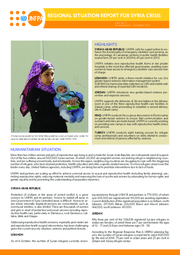You are here
New Releases
Regional Situation Report For Syria Crisis #26 - October 2014
The ongoing crisis in Syria and its spillover effects continue to inflict a devastating human and humanitarian toll on neighbouring countries. The rising numbers of displaced persons, the increasing pressure on refugee hosting countries and dwindling international support left governments that already face economic and social challenges, along with the United Nations agencies, including UNFPA, racing to meet the pressing humanitarian needs on the ground.
Humanitarian Bulletin, Syria crisis: June - July 2014
Now, in the fourth year of the conflict, there are 2.9 million Syrian refugees registered in the region. The number of refugees continues to increase and camps and informal settlements are growing, some into sizeable cities. The highest number of Syrian refugees are in Lebanon, followed by Turkey, Jordan, Iraq and Egypt; 75 per cent are women and children and 25 per cent are women and girls of reproductive age. Host populations are being faced with high prices and scarcity of basic services while governments and humanitarian agencies are struggling to tackle the crisis given the current security situation and economic challenges.
Pregnant and under fire
UNFPA provides maternal health care to women affected by the Syria crisis, but needs are growing.
Regional Situation Report For Syria Crisis #24 - August 2014
The risk of instability in the Middle East has increased as Syrian and Iraqi people continue to flee to neighboring cities and countries in order to escape the ongoing violence. Lebanon, Turkey, Jordan and Iraq continue to experience economic and political pressure as a result of the massive influx that has increased their population size and is straining their resources.

Regional Situation Report For Syria Crisis
SYRIAN ARAB REPUBLIC: UNFPA calls for urgent action to en¬hance the functionality of emergency obstetric care services, as the percentage of Caesarean sections in public health facilities soared from 29 per cent in 2009 to 45 per cent in 2013